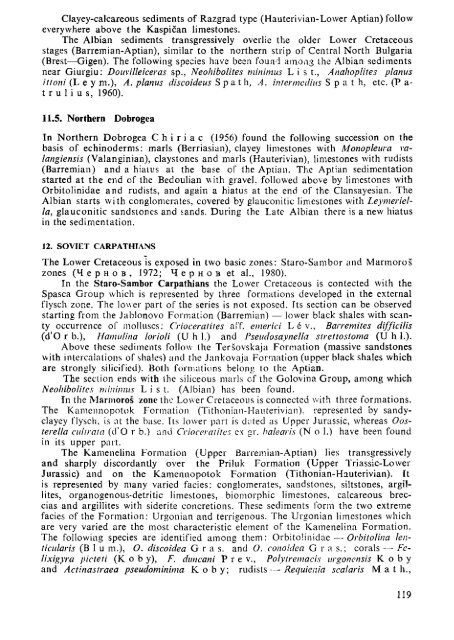THE MEDITERRANEAN LOWER CRETACEOUS
THE MEDITERRANEAN LOWER CRETACEOUS
THE MEDITERRANEAN LOWER CRETACEOUS
You also want an ePaper? Increase the reach of your titles
YUMPU automatically turns print PDFs into web optimized ePapers that Google loves.
Clayey-calcareous sediments of Razgrad type (Hauterivian-Lower Aptian) follow<br />
everywhere above the Kaspican limestones.<br />
The Albian sediments transgressively overlie the older Lower Cretaceous<br />
stages (Barremian-Aptian), similar to the northern strip of Central North Bulgaria<br />
(Brest—Gigen). The following species have been found among the Albian sediments<br />
near Giurgiu: Douvilleieeras sp., Neohibolites minimus List., Anahoplites planus<br />
ittoni (Ley m.), A. planus discoideus Spath, A. intermedius Spath, etc. (P at<br />
г u 1 i u s, 1960).<br />
11.5. Northern Dobrogea<br />
In Northern Dobrogea С h i r i a с (1956) found the following succession on the<br />
basis of echinoderms: marls (Berriasian), clayey limestones with Monopleura valangiensis<br />
(Valanginian), claystones and marls (Hauterivian), limestones with rudists<br />
(Barremian) and a hiatus at the base of the Aptian. The Aptian sedimentation<br />
started at the end of the Bedoulian with gravel, followed above by limestones with<br />
Orbitolinidae and rudists, and again a hiatus at the end of the Clansayesian. The<br />
Albian starts with conglomerates, covered by glauconitic limestones with Leymeriella,<br />
glauconitic sandstones and sands. During the Late Albian there is a new hiatus<br />
in the sedimentation.<br />
12. SOVIET CARPATHIANS<br />
The Lower Cretaceous is exposed in two basic zones: Staro-Sambor and Marmoros<br />
zones (Чернов, 1972; Чернов et al., 1980).<br />
In the Staro-Sambor Carpathians the Lower Cretaceous is contected with the<br />
Spasca Group which is represented by three formations developed in the external<br />
flysch zone. The lower part of the series is not exposed. Its section can be observed<br />
starting from the Jablonovo Formation (Barremian) — lower black shales with scanty<br />
occurrence of molluscs: Crioceratites aff. emerici Lev., Barremites difficilis<br />
(d'O r b.), Hamulina lorio/i (U h 1.) and Pseudosaynella strettostoma (U h 1.).<br />
Above these sediments follow the Tersovskaja Formation (massive sandstones<br />
with intercalations of shales) and the Jankovaja Formation (upper black shales which<br />
are strongly silicified). Both formations belong to the Aptian.<br />
The section ends with the siliceous marls of the Golovina Group, among which<br />
Neohibolites minimus List. (Albian) has been found.<br />
In the Marmoros zone the Lower Cretaceous is connected with three formations.<br />
The Kamennopotok Formation (Tithonian-Hauterivian), represented by sandyclayey<br />
flysch, is at the base. Its lower part is d^ted as Upper Jurassic, whereas Oosterella<br />
cultrata (d'O r b.) and Crioceratites ex gr. halearis (N о 1.) have been found<br />
in its upper part.<br />
The Kamenelina Formation (Upper Barremian-Aptian) lies transgressively<br />
and sharply discordantly over the Priluk Formation (Upper Triassic-Lower<br />
Jurassic) and on the Kamennopotok Formation (Tithonian-Hauterivian). It<br />
is represented by many varied facies: conglomerates, sandstones, siltstones, argillites,<br />
organogenous-detritic limestones, biomorphic limestones, calcareous breccias<br />
and argillites with siderite concretions. These sediments form the two extreme<br />
facies of the Formation: Urgonian and terrigenous. The Urgonian limestones which<br />
are very varied are the most characteristic element of the Kamenelina Formation.<br />
The following species are identified among them: Orbitolinidae — Orbitolina lenticularis<br />
(В 1 u m.), O. discoidea Gras, and O. conoidea G r a s.; corals — Felixigyra<br />
picteti (К о b y), F. duncani P r e v., Polytremacis urgonensis К о b y<br />
and Actinaslraea pseudominima К о b y; rudists — Requienia scalar is Math.,<br />
119

















